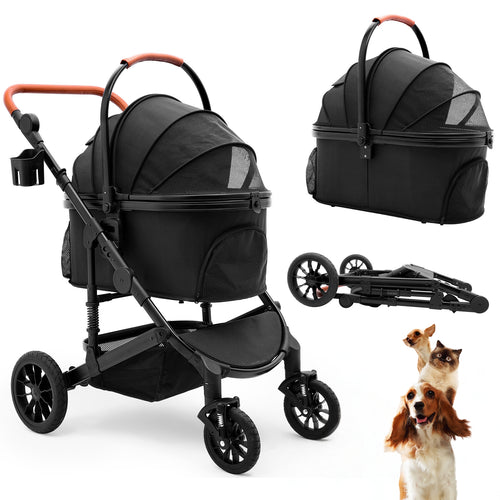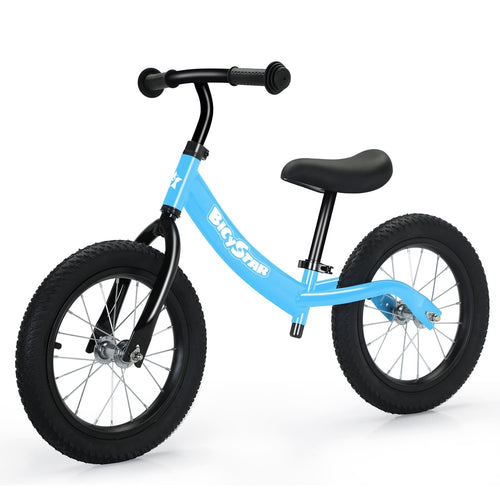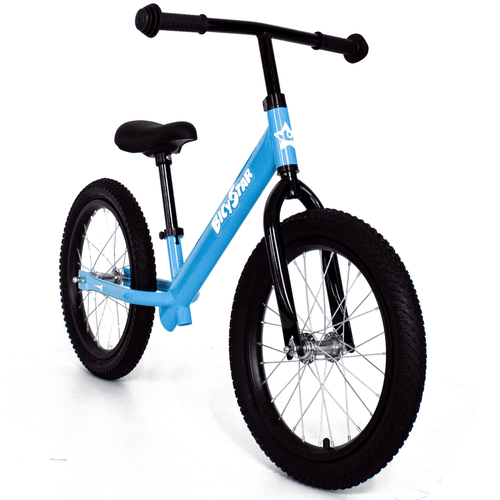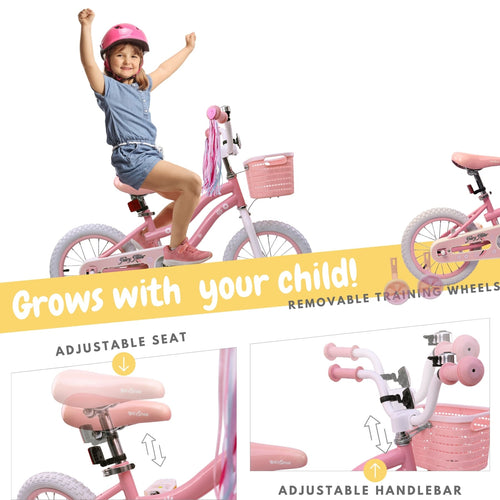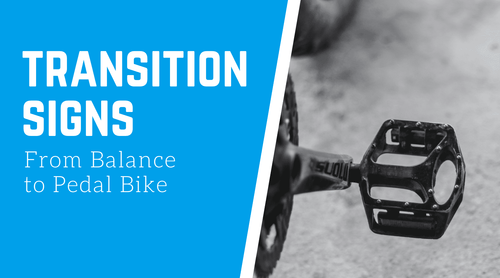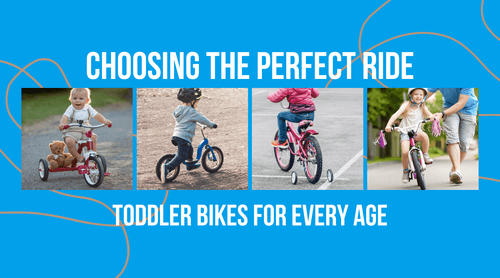Introduction: The Journey Begins with Balance
Embarking on the journey of parenting comes with a series of memorable firsts—among those, the poignant moment your child sets off on their first bike ride. Gone are the days when tricycles and training wheels dominated our driveways. In their place, balance bikes have surged in popularity, steering a new course for childhood development and adventure. But with this rise comes an essential question for every eager parent: At what age should my child start on a balance bike?
As a dedicated cycling enthusiast and determined supporter of the next generation of riders, I have delved deep into the world of balance bikes—not just as a concept, but as a pivotal tool in nurturing independence and coordination in young adventurers. In my blog, I'm going to unravel the mystery of the best age for your child to begin their two-wheeled journey and how to select the best balance bike to support their ride.

The goal here is simple; to provide you with a comprehensive understanding of balance bikes for toddlers and a practical insight into why they're becoming the first choice for kids ready to explore on two wheels. It's about matching not just the size of the bike to your child but also their readiness and eagerness to start pedaling—or in this case, balancing—towards their own little adventures.
Throughout this article, we'll explore the benefits of balance bikes for kids, perfect sizing, key buying tips, and when it's time to encourage your child to transition from balance bike superhero to pedal bike explorer. We'll delve into the nitty-gritty details that will ensure, by the time you reach the end of this article, you'll feel equipped and confident to make the right choices for your budding cyclist.
Remember, whether it's the first wobbly glide or a confident sprint down the path, starting your child on a balance bike is more than a rite of passage—it's the first pedal stroke towards independence. So grab a helmet and let's coast through this guide together. And don't forget to subscribe to the newsletter for even more insights and tips to keep you two-wheel savvy—because the only thing better than watching your child ride is knowing you provided the perfect launchpad for their journey.
What is a Balance Bike and Why Choose One for Your Toddler?
A balance bicycle takes a unique approach to cycling for youngsters. It's a pedal-less bike that teaches kids the essential skill of balancing on two wheels, gearing them up for an easier transition to a regular pedal bike, like a mountain bike when they're ready. Unlike training wheels, which provide a crutch that can inhibit the development of balance, balance bikes encourage the natural development of motor skills, coordination, and confidence in young riders.

The simplicity of a balance bike's design allows toddlers to concentrate on the core aspect of cycling than regular bike: balance. By using their feet to push off and stop, children learn to moderate their speed, maneuver, and ultimately, cruise without assistance. This hands-on approach fosters a deeper understanding of the physical demands of riding and equips kids with the skill set to ride a pedal bike without ever needing stabilizers.
Choosing a balance bike for your toddler over a traditional pedal bike with training wheels means providing a potentially smoother, more intuitive path to cycling proficiency. These bikes are lighter than their pedal-laden counterparts, making them easier for a kid to handle. Tipping is less likely with balance bikes as bikes are much easier to balance, given that kids can use their legs immediately to catch themselves, reducing the risk of falls and increasing safety. Moreover, since toddlers feel in control, they're more likely to enjoy the ride and want to continue improving their skills, making balance bikes an effective stepping stone to proper bikes.
Parents often appreciate balance bikes, especially for age 3, because they're low-maintenance. Without the complexities of pedals, chains, and gears, there's less to go wrong; this is why balance bikes sometimes are preferred over mountain bikes. This makes a balance bike an ideal introductory two-wheeler: it's all about hopping on and having fun. Plus, very young children, who might struggle with the concept and coordination of pedaling, can quickly hop on a balance bike and start gliding, turning every walk into a ride filled with laughter and excitement.
The joy on a child’s face as they zip along on their balance bike is a testament to the freedom and fun these bikes provide. It's more than just play; it’s an exercise in growth and learning—empowering even the littlest legs to embark on big adventures. Selecting the favorite balance bike for your toddler isn't just a purchase; it's an investment in their physical and cognitive development, and a stepping stone to a lifelong love of cycling. So when you're ready to unlock this new world for your child, consider buying a balance bike, maybe even higher-end bikes, that ensures safety, fun, and a love for riding.
At What Age Can Toddlers Start Riding Balance Bikes?
Determining the perfect age for your child to begin their biking adventure can feel akin to finding the right moment to let go as they pedal away. The consensus among experts and parents alike is that toddlers can start riding balance bikes much earlier than pedal bikes, with the recommended age typically between 18 months and 2 years. This is when a toddler's motor skills are sufficiently developed for walking and running, which are the basic skills they’ll use to propel and balance themselves on a bike.

Now, before you rush off to find the best balance bike on the market, it's pivotal to consider your child's individual development. Some toddlers may show an eagerness and aptitude for physical activities sooner than others. Observing your child’s coordination and comfort with walking and running can give you a clear sign they’re ready to transition to a balance bike. If they can comfortably and confidently walk, they’re likely ready to balance a bike—with parental guidance and supervision, of course.
When introducing your toddler to a balance bike, take it slow. Ensure the bike's seat height is adjusted so that their feet can firmly touch the ground, allowing them to stride and stop the bike with ease. This seat height adjustment is crucial as it offers the support they need to develop their balancing skills while also providing safety through the ability to stop the bike with their feet.
Remember, learning to ride is not a race—it’s a different pace for each little face. A balance bike for your toddler should be a source of joy and a means to gently coax their innate sense of adventure. It's less about the destination and more about the journey, the small triumphs, and the giggles in between. Encourage them to enjoy their newfound mobility and freedom, letting their curiosity pave the path ahead.
One last point to consider is that while age plays a significant role in determining when to start, size and fit are just as important. Look for a bike, perhaps a budget balance bike, that's suitable for your toddler's size now, not one they will grow into. A larger balance bike will be unwieldy and intimidating for your little one, stifling their confidence and progress. Conversely, a bike that fits perfectly will feel like an extension of themselves, an ally on their quest for adventure and independence.

In conclusion, the age at which your toddler is likely ready for a balance bike marries closely with their individual development and thirst for exploration. Watch for cues of readiness and choose a bike that fits their current size to help them discover the joy of balance and movement. With each stride, your child isn't just riding; they're stepping towards greater self-assurance on two wheels and beyond.
What to Look For in the Best Balance Bike
When you’re looking for the best balance bike, you'll quickly find the best choice abound. However, not all balance bikes are created equal, and the ‘best’ one is the one that aligns with your child’s needs and safety. To find that perfect bike, there are key considerations that shouldn't be overlooked — primarily, bike sizing and critical features that will enhance the riding experience.
Bike Sizing and Seat Height
Selecting the right balance bike for your young rider is much like choosing the proper shoes — it has to fit just right for comfort, safety, and proper development. An essential factor is ensuring that you opt for the correct seat height and balance bike size to match your child's current stage of growth.
Choosing the Right Balance Bike Size

Balance bikes are not one-size-fits-all and come in various wheel sizes, which are typically correlated with your child's age and their inseam for ease of selection:
- 10" Balance Bikes: These bikes are often the starting point for the youngest cyclists. Recommended for ages 1-3 years old, 10" bikes cater to smaller statures and offer the easiest transition from walking to balancing on wheels.
- 12" Balance Bikes: The 12" model is a versatile option that suits a broader age range, fitting children from 1.5 to around 5 years old. This size can often be the best choice for many kids, providing the necessary adjustability as they grow.
- 14" Balance Bikes: A 14" balance bike steps up to cater to those who start a little later or have quickly outgrown their first bike. Ideal for kids aged 4-6 years, these bikes build on the fundamentals of balance developed on smaller frames.
- 16" Balance Bikes: Targeted at older children, aged 5-9 years, 16" balance bikes for older kids capture those still mastering their balancing skills before transitioning to a pedal bike or who are tall for their age and need a larger bike for physical comfort and optimal control.
The Importance of Seat Height
The correct seat height is essential to any balance bike experience. The rule of thumb remains consistent across all sizes: the seat should be adjustable to a height where your child's feet can rest flat on the ground. This grants them the leverage to push off, glide, and brake safely with their legs. An improperly adjusted seat height can deter your child's independent efforts to ride and balance, slowing and even regressing their skill development.
Features to Consider for a Great Bike
Not all balance bikes are simple two-wheelers. Some come with unique features that can offer additional benefits, or perhaps suit your child better:
- Brakes: Hand brakes are great for teaching the fundamentals of stopping a bicycle and are particularly valuable as toddlers grow and ride faster. Having a brake on bikes also encourages them to use their feet less for stopping and more for balancing and propelling the bike —a crucial step if you're looking to transition them to a pedal bike later on.
- Tires: Balance bike tires come in different styles—air tires, foam tires, and rubber tires. Bikes with air tires typically provide better traction and cushioning, offering a smoother ride over varied terrain, similar to a regular adult bike. They can also be adjusted for different riding conditions. However, they require maintenance and can be punctured. Foam and rubber tires, on the other hand, are puncture-proof and require no maintenance but might not offer the same level of comfort or traction.
- Footrest: Some balance bikes come with footrests where kids can place their feet once they gain momentum and are gliding. Footrests should be intuitively placed and not obstruct the natural stride when they are pushing the bike along.
Remember, the best balance bike for your child should feel like a seamless extension of their playtime — intuitive, fun, and freeing. It should invite them to explore further, encourage their balance and coordination skills, and grow with them. This means choosing a bike that not only best fits them in terms of size but also has features that support their learning experience. Moreover, an ideal balance bike can be comfortable and safe for your toddler to use most days, hence considering quality over just price could mean fewer falls, less frustration, and more joyful riding.

In summary, evaluating the right size and features according to your child's needs will guide you to the best balance bike, creating a gateway to explore, learn, and build the confidence necessary to become a future cyclist. Keep these factors in mind, and you'll not only find a balance bike that your toddler loves, but also one that nurtures their development and enthusiasm for riding.
Balance Bikes that Convert to Pedal Bikes: A Long-Term Investment
Investing in a convertible balance bike can be akin to finding a treasure that evolves with your child's growth—not just physically but in their biking skills as well. These convertible bikes are a fantastic compromise for parents who are watching their budgets and those seeking longevity in a single purchase. But what exactly does this option entail, and is it the right choice for your little explorer?
The Versatility of Convertible Balance Bikes
A balance bike that converts offers you a unique two-in-one solution. Initially, it functions as a regular balance bike, helping your child to learn and hone their balancing and steering skills. Then, as they grow in confidence and ability, the bike can transform—usually by adding pedals—to the first pedal bike. This means you're effectively getting two bikes for the price of one and your child gets to maintain the comfort of riding a familiar bike as they take the next step in their cycling journey.
The transition from a balance to a pedal bike can be a big one for a toddler. The skill set expands as they have to learn about pedaling dynamics and potentially navigating bike gears. A convertible bike smooths out this learning curve because it removes the intimidation factor; there's a sense of safety and familiarity in the transition, allowing your child to focus solely on mastering pedals.
Considering Convertible Bikes: Practicality Meets Budget
When you're looking to convertible bike, a convertible option often seems like a great choice since it extends the life of the product beyond the early balancing stage. It saves you the expense and hassle of purchasing a whole new bike once your child is ready for pedals—your wallet and storage space will thank you! Moreover, convertible balance bikes tend to be built to last, seeing your child through years of use.

However, remember to vet these convertible options just as rigorously as you would a standard balance bike or pedal bike. Check for high-quality construction, ease of conversion, and ensure that the bike still meets all the necessary criteria for quality bikes use. The seat height should still be adjustable to cater to your growing toddler, the frame should maintain its lightweight nature for ease of use, and the addition of pedals shouldn't hinder the bike's original balance and rideability.
Longevity vs. Specialization: A Consideration
Before making a commitment to a convertible bike, it's worth considering whether a specialized bike may better serve your child's immediate needs. Specialized balance bikes are designed solely for the purpose of balancing and may offer better features specific to this learning phase, such as lighter frames and more appropriate geometry. While convertible bikes are practical, a dedicated balance bike might provide a superior experience during the crucial early stages of learning to balance.
In essence, a balance bike that converts is a thoughtful choice for those looking for a versatile, cost-effective solution. It embraces the growth journey of a child, from those first tentative strides to the proud pedals of achievement. As you ponder over this potentially long-term investment, weigh the pros and cons and envision your child's comfort and progression to decide if this is indeed the best balance bike route for your family's needs. With the right convertible bike, you might just set the stage for a seamless switch to pedaling, underpinned by undeniable fondness and familiarity.
Adjusting Seat Height for Growing Toddlers
As your child grows, their balance bike needs to adapt with them. The seat height of their bike is not merely a number—it's a critical measure that can have a profound impact on their comfort, control, and confidence on two wheels. Getting this aspect right is paramount for ensuring ongoing enjoyment and development in their riding journey.
The Significance of Seat Height Adjustment
Correct seat height is about striking a balance. Your toddler should be able to sit comfortably with their feet flat on the ground, allowing them to push themselves along and easily stop the bike with their legs. As they gain confidence and master balance, you can slightly raise the seat to encourage them to stretch their legs a bit more, which helps to enhance their gliding time.

Raising the seat incrementally allows for a gradual increase in the challenge of balancing, preparing your toddler physically and mentally for the eventual transition to a pedal bike. This approach ensures that the balance bike, even a budget balance bike, remains a useful tool for development rather than a toy that is quickly outgrown or, worse, a source of struggle if it's improperly sized.
How to Get the Best Fit as Your Child Grows
The process of adjusting the seat height should be straightforward. Many of the best balance bikes come with quick-release clamps or easy-to-use tools for adjustment, making it possible to change the height in a matter of seconds. This is valuable since you might find yourself adjusting the seat often as your child hits growth spurts.
When checking for the best fit, have your child sit on the bike with their feet flat on the ground, and observe. Their knees should have a slight bend when seated on a bike with a minimum seat, and they should be easily able to reach the handlebars without having to lean forward too much. Comfort is crucial because an awkward posture can discourage them from riding and can even cause strain over time.
Longevity in the Life of a Balance Bike
Seat height in bikes also isn't just about the present—it's a feature that can add longevity to the life of a balance bike. When sizing a balance bike for your toddler, consider the range of adjustment that the bike offers. Some bikes are designed with a taller or shorter minimum seat height, while others have a wide range of height adjustments, which can make a bike suitable for several years.
This consideration is particularly important for a balance bike that converts to a pedal bike. You want to be sure that the same principles apply once it transforms, with easy adjustments and a range of height options that will allow the bike to grow along with your child.
Adjusting the seat height for your growing toddler is a practice that supports ongoing development in their cycling skills. By investing in a bike with adjustable seat height, you're not just providing them with a toy; you're giving them a tool that evolves with them—a companion that supports their desire to explore the world on two wheels.
In conclusion, as parents, we should be vigilant about our children's comfort and the adaptability of their balance bikes, ensuring they get the perfect bike that’s fit for their current and future adventures. Regularly checking and adjusting the seat height will ensure that the balance bike experience remains both a lot of fun and developmentally appropriate.
Teaching Your Child to Ride a Balance Bike

The moment has arrived; your child, wide-eyed and expectant, stands before their new balance bike. It's bright and shiny and just the right size, but how do you instill the confidence in them to take those first tentative strides? Teaching your child to ride a balance bike is not only about introducing them to the mechanics of biking but also about guiding them through an experience that builds independence and joy.
Fostering Confidence Through Guided Play
Learning to ride begins with comfort and familiarity. Start by letting your child walk with the bike, guiding it along. This allows them to feel that they are in control and nothing about the bike is threatening. As a parent of either ages 3 to 5, your role is to offer encouragement and remain patient. Celebrate their small wins, such as sitting on the bike or pushing it along, to boost their confidence.
Once they demonstrate comfort with the bike, encourage them to take small, seated strides. Emphasize the fun—make it a game to see how many steps they can take or how long they can glide after pushing off. These exercises serve as the building blocks of balance, and before you know it, those steps will turn into glides.
Transitioning from Gliding to Balancing
When your child starts to glide, cheer them on to lift their feet off the ground for short intervals. This crucial step is where they learn to trust the two wheels beneath them. A bike that has been well-chosen for its size will play a key role here, as it's essential for your toddler to feel the security of being able to stop the bike with their feet whenever they need to.
It's during this phase that children often experience the thrill of momentum, and with your encouragement, they'll start experimenting with longer glides and more speed. Always ensure safety comes first by outfitting them with a properly-sized helmet and knee pads, especially as their confidence and speed increase.
Recognizing When They're Ready for a Pedal Bike
As your child becomes a seasoned balance bike rider, they'll show signs that they're ready for the next challenge: riding a pedal bike. These signs might include longer glide times, better steering control, and a higher level of comfort at faster speeds. When you notice these, it may be time to begin the conversation about the transition and get them excited for the next stage in their biking journey.

Preparing your child for a pedal bike involves more than just physical readiness; it's also about emotional readiness. Make sure they show interest in moving on, which helps assure a smoother transition. Some balance bikes that convert to pedal bikes make this step less daunting, allowing your child to remain on the machine they trust as it evolves to meet their growing skills.
In conclusion, teaching your child to ride a balance bike is a collaborative process that extends beyond the bike. It’s about building a bond of trust and communication as much as it is about developing physical skills. This period can be filled with incredible growth, laughter, and memorable moments that both of you will cherish. And in time, you'll find that the lessons learned go beyond biking—they're about tackling life's adventures, both big and small, with balance and enthusiasm.
Balance Bike Sizing and Buying Guide: Do's and Don'ts
The decision to purchase a balance bike for your child is laden with anticipation of sunny days spent zipping around parks and pathways. But to ensure those days are as blissful as imagined, getting the sizing and buying process right is paramount. There's a fine art to selecting the ideal balance bike—one that comfortably suits your toddler now and can adapt as they grow.
Do's for Balance Bike Sizing and Buying
- Do measure your child's inseam: Accurate measurements provide a baseline for selecting a bike with the correct seat height. The goal is for your child to sit on the saddle with their feet flat on the ground, offering stability and control.
- Do prioritize adjustability: A balance bike with an adjustable seat and handlebars grows with your child, extending the bike's usefulness and ensuring it remains a comfortable fit for longer periods.
- Do consider the weight of the bike: Toddlers should be able to maneuver their bike without struggle, so a lightweight bike is ideal. A good rule of thumb is that the bike should weigh no more than 30% of your child's weight.
- Do inspect for durability: Quality balance bikes will have sturdy frames, durable tires, and rust-resistant components that stand up to the rigors of regular use.
- Do test the bike: If possible, let your child try out the bike to gauge their comfort and ensure it's a good fit. Their immediate reaction can be very telling of how well they'll connect with the bike.
Don'ts for Balance Bike Sizing and Buying
- Don't buy too big: It might be tempting to purchase a balance bike your child will 'grow into,' but a bike that's too large can be intimidating, making the learning process frustrating and unsafe.
- Don't overlook the brakes: While not all balance bikes come with brakes, they can be a useful feature, especially as children pick up speed and need to learn about bike safety.
- Don't ignore tire type: The terrain your child will be riding on should inform the tire choice. For most urban and park settings, standard foam or rubber tires will suffice, but if you anticipate lots of outdoor riding on varied surfaces, air tires might be more appropriate.
- Don't compromise on comfort: A padded seat, grip handles, and an overall ergonomic design are important for lengthy rides. Discomfort can deter your child from using the bike altogether.
- Don't forget the helmet: Never undermine safety. Always buy a certified helmet along with the bike and ensure your child wears it every time they ride, no matter how short the distance might be.

In summary, purchasing a balance bike is not as simple as picking one off the shelf or adding the first Google result to your cart. It's about careful consideration, knowing your child’s needs, and understanding that the best balance bike is one that is safe, comfortable, embodies longevity, and above all, ignites a passion for riding. Stick to these do's and don'ts and you'll be set for success, poised for the wonderful view of your child gleefully gliding by, ready for the many adventures that lie ahead on their trusty two-wheeled steed.
Remember, every ride starts with balance, and every confident child started with support. Let's continue this journey together, one balance bike newsletter at a time. Because when it comes to your child's biking adventure, why not take the route that offers support, knowledge, and a community? Subscribe to our newsletter today, and let's keep the wheels of learning and fun turning!



